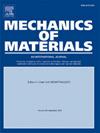Exploring mechanical damage in fascia: Experiments and advanced constitutive modeling approaches
IF 3.4
3区 材料科学
Q2 MATERIALS SCIENCE, MULTIDISCIPLINARY
引用次数: 0
Abstract
Biological tissues exhibit complex structures that necessitate mechanical models incorporating details of their key components and the physical processes occurring within the material. Our objective is to enhance the understanding of damage mechanisms in fibered tissues through mechanical testing. This includes conducting uniaxial tensile tests on fascia beyond physiological stretch limits and developing two constitutive models to describe damage and rupture. These models integrate both phenomenological and microstructural perspectives.
Two perpendicular directions, corresponding to the two families of collagen fibers, were compared: the longitudinal direction, characterized by greater stiffness, and the transverse direction. The mean Cauchy rupture stress () was reported as 16.67 for the longitudinal direction and 4.76 MPa for the transverse direction, with a significant difference observed between them (-value 0.05). Similarly, a significant difference in stored strain energy was found between the two directions (-value 0.05) between directions, being in longitudinal equal to 1.33 and 0.49 in transversal one. However, rupture stretches () did not exhibit a significant difference (-value 0.05) with values of 1.17 and 1.22 for the longitudinal and transverse directions, respectively.
In this study, a hyperelastic constitutive model for fascia was modified to incorporate damage effects into the strain energy function. Additionally, an extended version of a microstructural damage model was developed to effectively replicate the experimental data. The proposed damage models successfully captured the stress–strain behavior and accurately represented the damage process. The coefficient of determination for the fitted data ranged from 0.616 to 0.973, except for Sample IV, which exhibited an value of 0.251 when using the phenomenological model. In all cases, the microstructural model provided a more accurate fit compared to the phenomenological model, with values ranging from 0.748 to 0.927.
探索筋膜的机械损伤:实验和先进的本构建模方法
生物组织表现出复杂的结构,需要结合其关键成分和材料内发生的物理过程细节的机械模型。我们的目标是通过力学测试来增强对纤维组织损伤机制的理解。这包括对超出生理拉伸极限的筋膜进行单轴拉伸试验,并开发两种本构模型来描述损伤和破裂。这些模型结合了现象学和微观结构的观点。两个垂直的方向,对应于胶原纤维的两个家族,进行比较:纵向,其特点是更大的刚度,和横向。纵向平均柯西断裂应力(σr)为16.67,横向平均柯西断裂应力(σr)为4.76 MPa,二者之间存在显著差异(p值<;0.05)。同样,两个方向的存储应变能也存在显著差异(p值<;0.05),纵向为1.33 N·mm/mm3,横向为0.49。然而,断裂拉伸(λr)没有表现出显著差异(p值>;0.05),纵向为1.17,横向为1.22。本文对筋膜的超弹性本构模型进行了改进,将损伤效应纳入到应变能函数中。此外,开发了一个扩展版本的微结构损伤模型,以有效地复制实验数据。所提出的损伤模型成功地捕捉了应力-应变行为,准确地表征了损伤过程。拟合数据的决定系数R2范围为0.616 ~ 0.973,除样本IV使用现象学模型时R2值为0.251外。在所有情况下,微观结构模型比现象学模型提供了更准确的拟合,R2值在0.748 ~ 0.927之间。
本文章由计算机程序翻译,如有差异,请以英文原文为准。
求助全文
约1分钟内获得全文
求助全文
来源期刊

Mechanics of Materials
工程技术-材料科学:综合
CiteScore
7.60
自引率
5.10%
发文量
243
审稿时长
46 days
期刊介绍:
Mechanics of Materials is a forum for original scientific research on the flow, fracture, and general constitutive behavior of geophysical, geotechnical and technological materials, with balanced coverage of advanced technological and natural materials, with balanced coverage of theoretical, experimental, and field investigations. Of special concern are macroscopic predictions based on microscopic models, identification of microscopic structures from limited overall macroscopic data, experimental and field results that lead to fundamental understanding of the behavior of materials, and coordinated experimental and analytical investigations that culminate in theories with predictive quality.
 求助内容:
求助内容: 应助结果提醒方式:
应助结果提醒方式:


